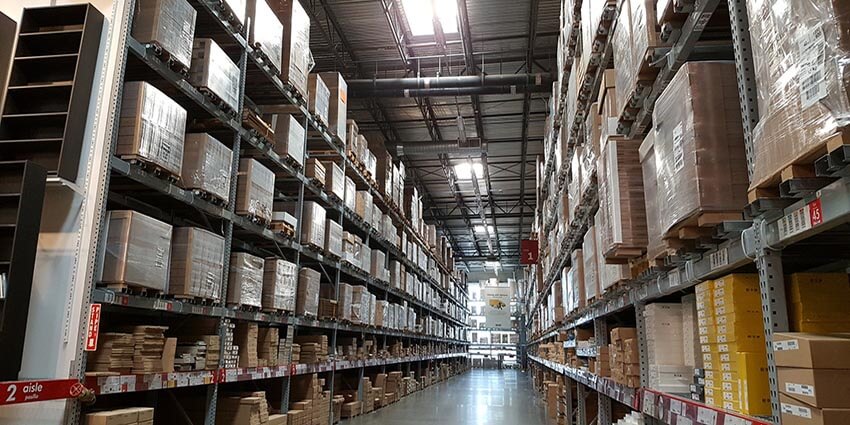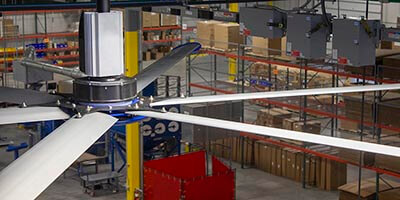Addressing Two Trends that will Strain Efficiency in the Warehouse

Online shopping grew significantly in the years leading up to 2020, but this growth accelerated as the pandemic’s severity increased. E-commerce is projected to be 14.4% of all retail spending and will grow to 19.2% by 2024 according to eMarketer magazine. Warehouses serving as storage and fulfillment centers managed to meet the demand, but the average age of these facilities is more than 30 years, and many fail to meet structural and geographic requirements for e-commerce.
IAQ often is more closely associated with residential and commercial buildings. However, poor IAQ affects warehouse operations more dramatically than one would expect. Many factors affect the quality of air inside warehouses. These include the type of products stored to the material handling equipment used. Other air quality factors also have a significant impact on warehouse operations. Employee well-being and safety, along with the integrity of the products being warehoused, are a few. Having the proper ventilation equipment addresses all of these needs while assisting the growing demand for online retail operations.
The heating, ventilating, and air conditioning (HVAC) system is an integral part of efficient warehouse operations but often overlooked as having a direct effect. Robotics, pallet and warehouse management systems account for many improvements in efficiency. However, the most efficient warehouses also pay close attention to the ventilation.
Benefits of a Well-Designed HVAC System
Removal of pollutants. Material handling equipment such as forklift trucks and other machinery typical in many warehouses contribute to pollutants in the building. However, modern distribution and fulfillment warehouses emphasizing last-mile delivery, often bring delivery vans into the facility, adding more harmful fumes and pollutants. Failure to remove these gases and other pollutants place employees at risk for breathing problems, congestion and allergies. Direct gas-fired make-up air units often are combined with variable volume exhaust fans to efficiently remove these pollutants and replace with fresh, conditioned air to maintain indoor air quality.
Improved productivity. A well-designed HVAC system ensures proper coverage throughout the warehouse facility regardless of the season and weather conditions outside. Another aspect of a well-designed HVAC system affecting productivity is thermal comfort. Workers who are too cold or hot do not function at peak performance. Keeping workers cool is particularly challenging and costly.
 |
| The HVLS fan is an important part of a total ventilation solution for warehouses. HVLS fans provide thermal comfort for employees, assist with safety and even help reduce structural and product damage. |
Cooling large warehouse spaces in summer to comfortable indoor temperatures of 70 to 75 degrees requires expensive equipment to install, operate, and maintain. Cost effective alternatives incorporate the use of high volume low speed (HVLS) fans. This type of fan enhances cooling by creating air velocity at the floor, resulting in a perceived cooling effect of 10 to 15 degrees. Additions to HVAC systems such as an HVLS fan can replace or enhance mechanical cooling systems without excessive cost.
Improved safety. The Occupational Safety and Health Administration (OSHA) ranks jobs in warehouses to be among the most dangerous. Proper ventilation reduces unhealthy air, keeping workers alert and able to function at peak levels. Accidents in the warehouse are another issue that proper ventilation can address. Issues such as sweating slab syndrome can cause wet areas on the floor that are a hazard to forklift traffic and can result in slips and falls. A well-designed HVAC system that includes proper air circulation helps maintain dry floors and surfaces. Proper ventilation that addresses the changing seasons and utilizes a combination of fans, louvers, and make up air equipment, helps mitigate these types of dangerous situations.
Protection against contagious disease. Many people may think by clicking the button on the online retail site is all that’s required for a package to appear on their porch. Those who understand the supply chain know there are many workers behind the scenes making that transaction happen. The work performed in the warehouse is crucial to fulfilling each order. Workers in warehouses exposed to contagious disease can slow or prevent order fulfillment from happening. Proper ventilation from a well-designed HVAC system will significantly reduce the spread of contagious airborne diseases.1
What comprises a well-designed HVAC system?
HVAC systems for warehouse operations vary. Specific designs factor in variables including geography, weather conditions, warehouse age, construction, and products on the pallet racks. However, most warehouses use a mix of the following components in its HVAC system design.
- Direct gas-fired make-up air units
- Axial upblast fans
- Operable intake louvers
- HVLS fans
- Hooded axial fans
- Sidewall propeller fans
- Air circulator fans
- Centrifugal exhaust fans
- Dedicated outdoor air systems
- Dampers
Many ventilation products work in concert to address challenges mentioned in the benefit section of this post. Future posts will provide more information on how these products add value to the successful warehouse as it attempts to meet the demands of continued e-commerce growth. Learn more about HVAC systems and individual components for warehouse and distribution center operations.
1https://www.ashrae.org/file%20library/technical%20resources/covid-19/ashrae-building-readiness.pdf


from